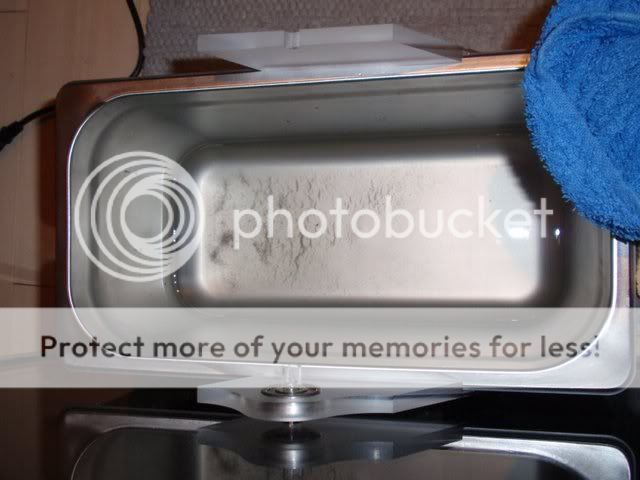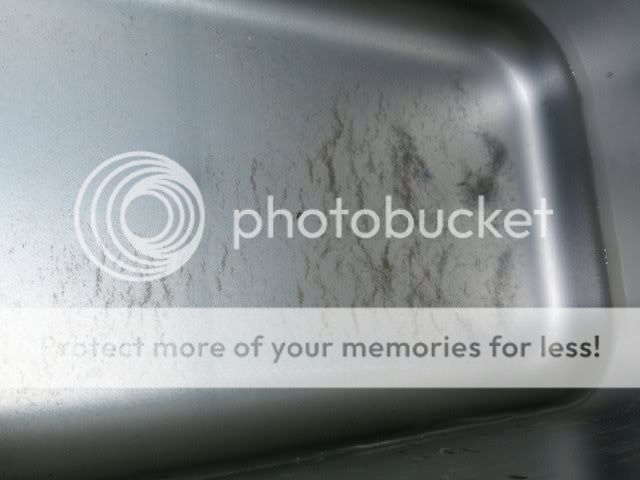joetama said:Wow that is a lot of gunk...
I've got some old vinyl family and friends have given me. I would be scared to see what I would get out of those records.
This has been a very awesome idea! Nice job.
Thank you Joe!
And you can just imagine how much microscopic dirt you can't see? 😀
Lars
Sclalars said:
Why did'nt you tell me, why, why
😀 😀
I did come up with a solution though, hold your breath 😉
Lars
Deep down i sensed there was a reason that you did not put it on the other side, your whole project seems so well thought out that I couldn't imagine you overlooking something like that. I must admit I find your solution simple, yet elegant. I am truly envious of your ability to work with acrylic like that, it is a beautiful machine. I am glad to hear that it works great. Did we ever discover anything about the possibility of ultrasonics eroding the vinyl?
-Justin
despotic931 said:
Did we ever discover anything about the possibility of ultrasonics eroding the vinyl?
-Justin
No, but it's been some discussion earlier in this thread.
Lars
PigletsDad said:For example, if you use an ultrasonic cleaner on a substrate for thin film growth, you get a very poor quality film with many defects, as there are damage sites both on the surface and immediately below.
AFAIK, sonication in increasingly volatile liquids is SOP for most thin film growth by mfg (@Intel for instance), and I know of several labs that use is successfully with epitaxial MBE and ALD. (sorry for so many acronyms, I blame the internet)
I know that using focused ion beam (skipped the acronym there!) causes significant surface and subsurface damage to about 20-100 Å, (depending on user experience) but thats at tens of kV, not ultrasonic energies.
Surface damage will be more likely with friable materials, and less likely with pliable materials. Vinyl is very pliable. Consider the pressure that the hard stylus places on the surface of the record, and compare that with the energy imparted by the sonic bath. My guess is that at the bath energies used here, the surface forces are orders of magnitude less than that of the stylus. All this is just semi-educated guesswork. Proof will be in the testing. So far, it looks good.
Sheldon
Sheldon
Sheldon said:Surface damage will be more likely with friable materials, and less likely with pliable materials. Vinyl is very pliable. Consider the pressure that the hard stylus places on the surface of the record, and compare that with the energy imparted by the sonic bath. My guess is that at the bath energies used here, the surface forces are orders of magnitude less than that of the stylus. All this is just semi-educated guesswork. Proof will be in the testing. So far, it looks good.
Sheldon
I am going to have to agree.
The whole point of the sonic bath is to clean things which you wouldn't want to use much force or an abrasive detergent on. I would imagine that it would be safe for Vinyl.
I've seen a Sonic Cleaner at Bed Bath and Beyond which said it was safe to clean CD's.
I almost purchased it...

Looks interesting. New here. Name is Duke.
Have a question. How do you keep the liquid from running onto the label after it rotates the wet part to the top, where it might run down? Or, did I miss that part?
Duke😕
Have a question. How do you keep the liquid from running onto the label after it rotates the wet part to the top, where it might run down? Or, did I miss that part?
Duke😕
Duke,
I think it's too slow of a turn to rotate the liquid over the top. See here, earlier in the thread.
http://www.diyaudio.com/forums/showthread.php?postid=1474512#post1474512
I think it's too slow of a turn to rotate the liquid over the top. See here, earlier in the thread.
http://www.diyaudio.com/forums/showthread.php?postid=1474512#post1474512
Duke, check out the speed this thing rotates. It has plenty of time to run back into the tank without damaging the label. Makes a turtle look like a cheetah! Good thing you can do so many at once.
Evan
Evan
Tanks
I like the concept.
Where does a person go about finding a tank and vibrator that is the right size. I found a smaller tank that can be used for jewelery can it be reporpused to use for records?
Thanks for the help.
I like the concept.
Where does a person go about finding a tank and vibrator that is the right size. I found a smaller tank that can be used for jewelery can it be reporpused to use for records?
Thanks for the help.
Re: Tanks
Search on Ebay. Certainly on the UK site there is exactly that tank!
SCD said:I like the concept.
Where does a person go about finding a tank and vibrator that is the right size. I found a smaller tank that can be used for jewelery can it be reporpused to use for records?
Thanks for the help.
Search on Ebay. Certainly on the UK site there is exactly that tank!
Cal Weldon said:Duke,
I think it's too slow of a turn to rotate the liquid over the top. See here, earlier in the thread.
http://www.diyaudio.com/forums/showthread.php?postid=1474512#post1474512
Yeah, I wondered if it was slow enough that the liquid would evaporate before it got high enough to run down. With the talk of "rinsing", and the pic of the "Commode-A-Dry LP Drip-Dryer", though, I wanted to make sure.😉
Thanks,
Duke
I think the next project needs to be some sort vertical vacuum drying machine that dries both sides of the record at the same time. Kinda like a dual VPI vacuum cleaner which has the record spinning vertically instead of horizontally and has a vacuum arm on both sides of the record. That was you can clean your records without ever actually physically touching the groves, and you will be sure that no residue is left behind!
-Justin
-Justin
The LP's need rinsing.
The water will sheet (run straight off) off clean vinyl... so you must have some detergent still on the disks.
I'd suggest a detergent wash, then an ultrasonic rinse.
Plain jane water is a pretty fiesty cleaner when used by itself in those baths....
Have fun
Owen
The water will sheet (run straight off) off clean vinyl... so you must have some detergent still on the disks.
I'd suggest a detergent wash, then an ultrasonic rinse.
Plain jane water is a pretty fiesty cleaner when used by itself in those baths....
Have fun
Owen
I use a soft, large nylon bristle paintbrush (3-5 inch wide), lukewarm water, and dish detergent (Joy).
Hold the record over the kitchen sink and paint lots of water/soap solution on it. Run the bristles through the grooves, take your time. Do both sides, then rinse thoroughly in lukewarm water under the faucet. Drop the record on a clean bath towel, then pat dry.
Hold the record over the kitchen sink and paint lots of water/soap solution on it. Run the bristles through the grooves, take your time. Do both sides, then rinse thoroughly in lukewarm water under the faucet. Drop the record on a clean bath towel, then pat dry.
have you done any tests to confirm that you are not causing damage to the records? Such as only cleaning half and listening for a change in the sound etc?
despotic931 said:have you done any tests to confirm that you are not causing damage to the records? Such as only cleaning half and listening for a change in the sound etc?
No, I haven't. All I can say, is that the records get really clean. And they sound wonderful afterwards. I don't know if there will be a long term damage though, but I can't really see why there should be? As long as the record looks fine, and plays fine?
I'll post a comment here though, if I discover such a problem. 😉
Lars
- Status
- Not open for further replies.
- Home
- Source & Line
- Analogue Source
- I made myself a record cleaner

